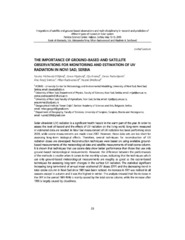| dc.contributor | Nina, Aleksandra | |
| dc.contributor | Radovanović, Milan | |
| dc.contributor | Srećković, Vladimir A. | |
| dc.creator | Malinović-Milićević, Slavica | |
| dc.creator | Mijatović, Zoran | |
| dc.creator | Arsenić, Ilija | |
| dc.creator | Podrašćanin, Zorica | |
| dc.creator | Firanj Sremac, Ana | |
| dc.creator | Radovanović, Milan | |
| dc.creator | Drešković, Nusret | |
| dc.date.accessioned | 2022-11-14T10:42:56Z | |
| dc.date.available | 2022-11-14T10:42:56Z | |
| dc.date.issued | 2019 | |
| dc.identifier.isbn | 978-86-80029-77-1 | |
| dc.identifier.uri | https://dais.sanu.ac.rs/123456789/13406 | |
| dc.description.abstract | Solar ultraviolet (UV) radiation is a significant health hazard in the warm part of the year. In order to assess the level of hazard and the effects of UV radiation on the living world, long-term measured or estimated data are needed. In Novi Sad measurement of UV radiation has been performing since 2003, while ozone measurements are made since 2007. However, those data sets are too short for assessing long-term biological effects. Therefore, several techniques for reconstruction of UV radiation doses are developed. Reconstruction techniques were based on using available ground-based measurements of the meteorological data and satellite measurements of total ozone column. It is shown that techniques that use ozone data show better performance than those that use only ground-based meteorological measurements. However, the difference between the performances of the methods is smaller when it comes to the monthly values, indicating that the techniques which use only ground-based meteorological measurements are roughly as good as the ozone-based techniques for assessing long-term changes in the surface UV radiation. The statistical significant increasing long term-trend of annual mean erythemal UV doses (ERY) and the decreasing trend in total ozone column in Novi Sad since 1981 have been noticed. An increase in ERY was noticed in all seasons except in autumn and it was the highest in winter. The analysis showed that the increase in the ERY in the period 1981-1996 is mainly caused by the total ozone column, while the increase after 1996 is largely caused by cloudiness. | sr |
| dc.language.iso | en | sr |
| dc.publisher | Belgrade : Geographical Institute "Jovan Cvijić" SASA | sr |
| dc.rights | openAccess | sr |
| dc.rights.uri | https://creativecommons.org/licenses/by-nc-nd/4.0/ | |
| dc.source | Integrations of satellite and ground-based observations and multi-disciplinarity in research and prediction of different types of hazards in solar system: book of abstracts | sr |
| dc.subject | UV radiation | sr |
| dc.subject | ozone | sr |
| dc.subject | measurements | sr |
| dc.subject | estimation | sr |
| dc.title | The importance of ground-based and satellite observations for monitoring and estimation of UV radiation in Novi Sad (Serbia) | sr |
| dc.type | conferenceObject | sr |
| dc.rights.license | BY-NC-ND | sr |
| dc.citation.spage | 23 | |
| dc.citation.epage | 23 | |
| dc.description.other | This conference was held from 10 to 13 May in Petnica Science Centre, City of Valjevo. | sr |
| dc.identifier.cobiss | 275944460 | |
| dc.type.version | publishedVersion | sr |
| dc.identifier.fulltext | http://dais.sanu.ac.rs/bitstream/id/53460/M34_2019_Petnica1.pdf | |
| dc.identifier.rcub | https://hdl.handle.net/21.15107/rcub_dais_13406 | |

